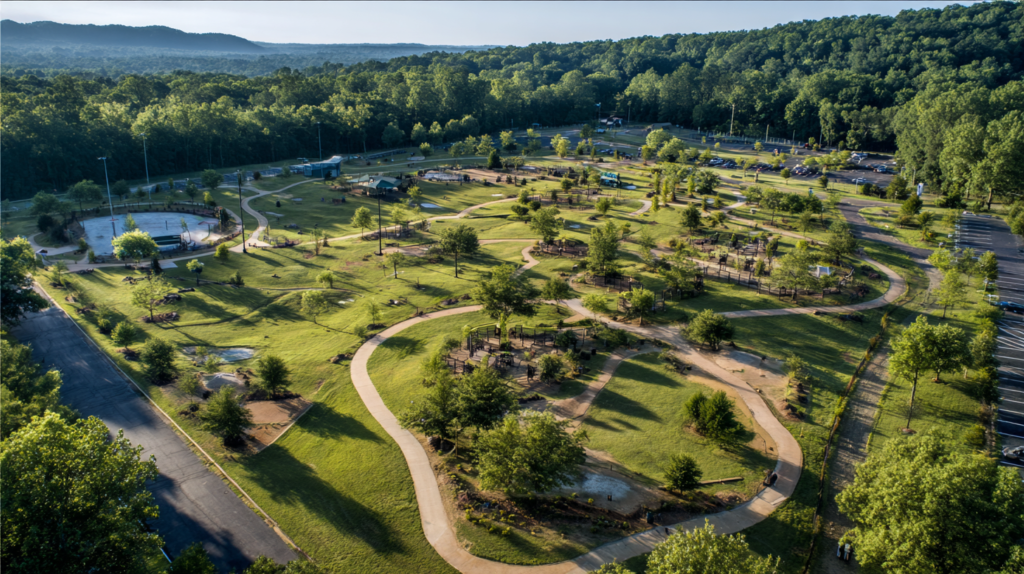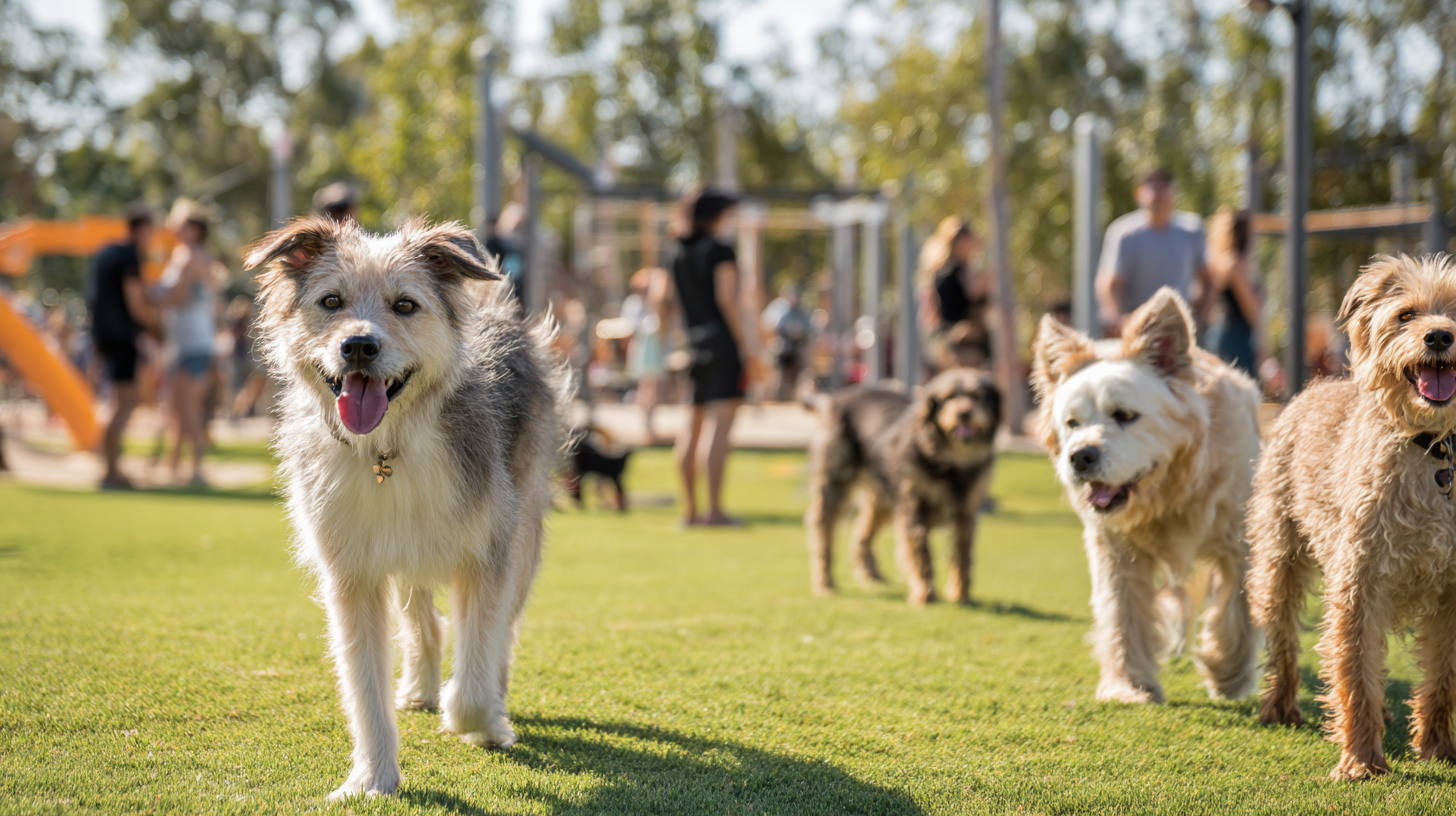Find the best dog park near me for safe off-leash fun! Expert guide to top-rated dog parks with amenities, safety tips, and what to look for in quality facilities.
Table of Contents
Did you know that 85% of dog owners report their pets show improved behavior and reduced anxiety after regular visits to dog parks? If you’re searching for the perfect “dog park near me,” you’re not alone—millions of pet parents seek safe, engaging spaces where their furry friends can socialize, exercise, and burn off energy. Finding the right dog park isn’t just about convenience; it’s about ensuring your dog’s safety, happiness, and overall well-being.
Whether you’re a first-time dog owner or a seasoned pet parent, choosing the right dog park can make the difference between a delightful outing and a stressful experience. In this comprehensive guide, we’ll explore the five best types of dog parks you should look for in your area, essential safety considerations, and expert tips to maximize your dog’s off-leash adventures.
What Makes a Great Dog Park Near Me?

Before diving into our top recommendations, it’s crucial to understand what separates exceptional dog parks from mediocre ones. A quality dog park near me should offer more than just an open space—it should provide a safe, clean, and engaging environment for both dogs and their owners.
Key Features of Outstanding Dog Parks:
The best dog parks feature secure double-gate entry systems that prevent escapes, separate areas for small and large dogs, adequate shade structures, and reliable water sources. Additionally, top-rated facilities maintain clean grounds, provide waste disposal stations, and enforce clear rules that promote positive interactions between pets and owners.
Safety Infrastructure Requirements:
Professional-grade fencing stands at least six feet high with no gaps or sharp edges. The ground surface should be well-maintained, free from hazards like broken glass, toxic plants, or deep holes. Proper drainage ensures the park remains usable even after rain, while strategic lighting extends usable hours during shorter winter days.
The 5 Best Types of Dog Parks to Search For
1. Multi-Zone Community Dog Parks
These comprehensive facilities represent the gold standard when searching for a dog park near me. Multi-zone parks typically feature separate areas for different dog sizes, agility equipment, and specialized zones for specific activities.
Why They’re Superior: Multi-zone parks reduce conflicts between dogs of different sizes and energy levels. Small dogs can play safely without being overwhelmed by larger breeds, while high-energy dogs have designated areas for intensive play. These parks often include:
- Separate small dog areas (under 30 pounds)
- Large dog zones with ample running space
- Agility equipment sections
- Quiet zones for senior dogs or timid pets
- Training areas for obedience practice
Real-World Example: Central Park’s dog runs in New York City serve over 50,000 dogs annually. Their multi-zone design has resulted in a 40% reduction in dog-related incidents compared to single-area parks, according to NYC Parks Department data.
2. Waterfront and Beach Dog Parks
If you’re fortunate enough to live near water, waterfront dog parks offer unique benefits that landlocked facilities can’t match. These specialized parks combine the joy of off-leash play with the natural appeal of water activities.
Unique Benefits: Water features provide natural cooling during hot weather, additional exercise opportunities through swimming, and mental stimulation through new sights and sounds. Many dogs naturally love water, making these parks particularly enriching for water-loving breeds like Labradors, Golden Retrievers, and Portuguese Water Dogs.
Safety Considerations: Always verify water quality and current conditions before allowing your dog to swim. Look for parks with designated shallow areas for inexperienced swimmers and easy entry/exit points. Some waterfront parks provide dog life jackets for rent—a thoughtful amenity that prioritizes safety.
3. Hiking Trail Dog Parks
For adventurous dogs and owners, hiking trail dog parks combine the benefits of off-leash freedom with the excitement of exploring natural terrain. These parks typically feature marked trails where dogs can roam freely while staying within designated boundaries.
Physical and Mental Benefits: Hiking trail dog parks provide superior exercise opportunities compared to flat, open areas. The varied terrain challenges different muscle groups, while new scents and environments offer rich mental stimulation. These parks are particularly beneficial for high-energy breeds and working dogs that need substantial physical challenges.
Trail Etiquette: Even in off-leash areas, maintain voice control over your dog. Carry a leash for emergency situations, and be prepared to recall your dog if you encounter wildlife, other hikers, or situations requiring immediate control.
4. Urban Rooftop and Indoor Dog Parks
City dwellers often face unique challenges when searching for a dog park near me. Urban rooftop and indoor facilities provide innovative solutions for densely populated areas where ground-level space is limited.
Innovative Features: Modern urban dog parks incorporate artificial turf designed specifically for pets, climate-controlled environments, and even treadmills for high-energy dogs. Some facilities offer professional supervision, training classes, and socialization programs led by certified animal behaviorists.
Year-Round Accessibility: Indoor dog parks shine during extreme weather conditions. Whether it’s scorching summer heat, freezing winter temperatures, or heavy rainfall, these facilities ensure your dog maintains consistent exercise routines regardless of outdoor conditions.
5. Specialty Breed-Specific Dog Parks
Some communities have embraced the concept of breed-specific or size-specific dog parks that cater to particular canine characteristics and needs. These specialized facilities recognize that different breeds have varying exercise requirements, play styles, and social needs.
Targeted Benefits: Breed-specific parks allow dogs with similar characteristics to play together more harmoniously. For example, sight hounds may have dedicated areas for running, while herding breeds might have spaces designed for their natural instincts to chase and gather.
Examples of Specialization:
- Bully breed meetups with reinforced equipment
- Senior dog areas with softer surfaces and gentle exercise options
- Puppy socialization zones with age-appropriate play equipment
- Working dog areas with job-simulation activities
Essential Safety Tips for Dog Park Visits
Pre-Visit Preparation
Before heading to any dog park near me, ensure your dog is up-to-date on vaccinations, including rabies, DHPP (distemper, hepatitis, parvovirus, parainfluenza), and bordetella. Many parks require proof of vaccination, and it’s crucial for preventing disease transmission in social settings.
Health Screening: Never bring a sick dog to a dog park. Signs that your dog should stay home include lethargy, coughing, diarrhea, vomiting, or any unusual behavior. Even minor illness can quickly spread in social environments where dogs share water bowls and play closely together.
During Your Visit
Supervision Requirements: Constant supervision is non-negotiable. Even well-behaved dogs can find themselves in unexpected situations. Stay off your phone and actively watch your dog’s interactions with others. Look for signs of stress, over-excitement, or potential conflicts.
Reading Dog Body Language: Understanding canine communication prevents problems before they escalate. Signs of stress include excessive panting, pacing, tail tucking, or trying to hide behind you. Overly excited dogs may display mounting behavior, excessive barking, or inability to settle down.
Emergency Preparedness
What to Bring: Always carry a first aid kit containing gauze, antiseptic wipes, and emergency contact information for your veterinarian. Bring your own water bowl to reduce disease transmission risk, and pack high-value treats for training and recall practice.
Incident Response: If your dog is involved in an altercation, remain calm and separate the dogs immediately. Never put your hands directly between fighting dogs—use a water bottle, loud noise, or physical barriers instead. Exchange contact information with other owners involved and document any injuries with photos.
Common Mistakes to Avoid at Dog Parks
Mistake #1: Bringing Food or Treats
Many dog parks prohibit food and treats because they can trigger resource guarding behaviors and create conflicts between dogs. Even friendly dogs may become possessive around food, leading to fights and injuries.
The Exception: Some parks allow treats specifically for training purposes, but use them sparingly and away from other dogs. High-value treats should be saved for recall training and positive reinforcement of good behavior.
Mistake #2: Ignoring Park Rules and Etiquette
Every dog park has specific rules designed to maintain safety and harmony. Common violations include bringing puppies under four months old, allowing aggressive dogs to continue playing, or failing to clean up after your pet.
Rule Enforcement: Don’t assume other owners will follow rules. If you observe violations that could endanger your dog, politely address the situation or consider leaving the park. Your dog’s safety takes precedence over social niceties.
Mistake #3: Overwhelming Shy or Anxious Dogs
Not all dogs are natural socializers. Forcing a shy or anxious dog into busy park situations can worsen their fear and create lasting negative associations with other dogs.
Gradual Introduction: Start with less crowded times, shorter visits, and observe your dog’s comfort level. Some dogs prefer one-on-one playdates rather than large group settings, and that’s perfectly normal.
When to Consult Your Veterinarian
Physical Injuries
Any injury sustained at a dog park warrants veterinary attention, even if it appears minor. Puncture wounds from bites can become infected, and what looks like a small scrape might involve deeper tissue damage.
Signs Requiring Immediate Care:
- Limping or favoring a leg
- Visible wounds or bleeding
- Excessive drooling or difficulty swallowing
- Lethargy or unusual behavior after park visits
- Persistent coughing or respiratory symptoms
Behavioral Changes
If your dog develops new behavioral issues after visiting dog parks, consult both your veterinarian and a certified animal behaviorist. Problems like increased aggression, fearfulness, or reluctance to interact with other dogs may indicate underlying issues requiring professional intervention.
Myth-Busting: Common Dog Park Misconceptions
Myth #1: “All Dogs Need Dog Park Socialization”
Reality: While many dogs benefit from dog park visits, not all dogs are suited for this type of socialization. Senior dogs, anxious dogs, and those with specific health conditions may find dog parks stressful rather than enjoyable.
The Truth: Quality socialization can occur in controlled settings like supervised playdates, training classes, or structured activities. The key is finding what works best for your individual dog’s personality and needs.
Myth #2: “Dog Parks Are Always Safe”
Reality: Dog parks carry inherent risks, including disease transmission, injuries from play, and behavioral incidents. While most visits are positive experiences, responsible owners must remain vigilant and prepared for potential problems.
Risk Mitigation: Choose well-maintained parks with active management, visit during appropriate times, and trust your instincts about situations that don’t feel safe.
Myth #3: “Dominant Dogs Need to ‘Work It Out'”
Reality: Allowing aggressive or overly dominant dogs to continue problematic behavior doesn’t teach them proper social skills—it reinforces negative patterns and puts other dogs at risk.
Professional Guidance: Dogs with persistent behavioral issues need professional training and behavior modification, not uncontrolled exposure to other dogs in park settings.
Step-by-Step Guide to Finding Your Perfect Dog Park
Step 1: Research Local Options
Start by searching online for “dog park near me” and reading reviews from other pet owners. Look for parks with high ratings, recent positive feedback, and mentions of good maintenance and safety features.
Online Resources:
- Local government websites often list official dog parks
- Pet community forums provide real user experiences
- Apps like BringFido offer user reviews and park details
- Social media groups share current park conditions and events
Step 2: Visit Without Your Dog First
Scout potential parks during busy times to observe the general atmosphere, cleanliness, and how other dogs and owners interact. Pay attention to park maintenance, available amenities, and overall safety features.
What to Look For:
- Secure fencing and proper gate systems
- Clean water sources and waste disposal stations
- Appropriate separation between small and large dog areas
- Evidence of regular maintenance and cleaning
- Positive interactions between dogs and owners
Step 3: Start with Short Visits
Begin with brief 15-20 minute visits during less crowded times. This allows your dog to explore the environment without overwhelming stimulation and gives you time to assess their comfort level.
Building Positive Associations: Bring high-value treats and make the experience enjoyable for your dog. If they seem stressed or uncomfortable, leave immediately and try again another day. Forced socialization often backfires and can create lasting negative associations.
Step 4: Gradually Increase Duration and Frequency
As your dog becomes comfortable, gradually extend visit length and frequency. Most dogs benefit from 30-60 minute sessions, but individual needs vary based on age, energy level, and social preferences.
Monitoring Progress: Keep a journal of your dog’s behavior before, during, and after park visits. Note any changes in appetite, sleep patterns, or general demeanor that might indicate stress or overexcitement.
Expert Tips for Maximizing Dog Park Benefits
Timing Your Visits
Optimal Schedule: Early morning visits (7-9 AM) typically attract serious dog owners with well-behaved pets. Evening visits (5-7 PM) can be busier but offer more socialization opportunities. Avoid peak weekend times if your dog is easily overwhelmed.
Seasonal Considerations: Summer visits should occur during cooler parts of the day to prevent overheating. Winter visits might be shorter but provide valuable exercise when other outdoor activities are limited.
Building a Regular Routine
Consistency Benefits: Regular park visits help dogs develop stable social relationships with other frequent visitors. Many dog owners form communities around their local parks, creating additional support networks for pet care advice and emergency assistance.
Rotating Locations: If possible, visit multiple parks to provide variety and prevent boredom. Different environments offer unique stimulation and prevent your dog from becoming overly territorial about one specific location.
Training Opportunities
Recall Practice: Dog parks provide excellent opportunities to practice recall training in distracting environments. Start with short distances and gradually increase the challenge as your dog’s response improves.
Social Skills Development: Use park visits to reinforce good manners like sitting before play, gentle greetings, and appropriate play behaviors. Consistent training in social settings helps dogs generalize good behavior to other situations.
The Future of Dog Parks: Emerging Trends
Technology Integration
Modern dog parks increasingly incorporate technology to enhance user experience and safety. Some facilities now feature:
- RFID entry systems that track usage and verify vaccinations
- Automated water fountains with temperature control
- Mobile apps for reporting maintenance issues or finding playmates
- Security cameras for monitoring and incident documentation
Specialized Programming
Structured Activities: Many parks now offer organized activities like agility training, puppy socialization classes, and breed-specific meetups. These programs provide additional structure and professional guidance for dog owners.
Educational Components: Some facilities include educational stations with information about canine behavior, health, and training. These resources help owners become more knowledgeable about their pets’ needs and improve overall park experiences.
Making the Most of Your Dog Park Experience
Building Community Connections
Networking Benefits: Dog parks naturally create communities of pet owners who share common interests and challenges. These connections often lead to valuable relationships, pet sitting arrangements, and shared knowledge about local veterinary services.
Organizing Meetups: Consider organizing breed-specific meetups or training sessions at your local park. These events can help shy dogs build confidence and provide structured socialization opportunities.
Seasonal Adaptations
Summer Strategies: During hot weather, bring extra water, seek shaded areas, and watch for signs of overheating. Consider portable shade structures or cooling mats for longer visits.
Winter Preparations: Cold weather requires different considerations, including paw protection from salt and ice, shorter visits for thin-coated breeds, and awareness of hypothermia risks.
Educational Table:
Markdown Version:
| Park Type | Best For | Key Features | Safety Level | Average Cost |
|---|---|---|---|---|
| Multi-Zone Community | All dog sizes | Separate areas, agility equipment, multiple zones | High | Free-$15/visit |
| Waterfront/Beach | Water-loving breeds | Swimming areas, natural environment | Medium | Free-$20/visit |
| Hiking Trail | High-energy dogs | Natural terrain, varied exercise | Medium | Free-$10/visit |
| Urban Indoor | City dwellers | Climate control, year-round access | High | $15-$30/visit |
| Breed-Specific | Specialized needs | Tailored equipment, similar-sized dogs | High | $10-$25/visit |
FAQ Section :
Q: How do I find the best dog park near me?
A: Research online reviews, visit parks without your dog first, and look for secure fencing, separate areas for different dog sizes, clean facilities, and positive interactions between dogs and owners.
Q: What should I bring to a dog park?
A: Bring water, waste bags, a first aid kit, vaccination records, and emergency contact information. Avoid bringing food or toys that might cause resource guarding.
Q: Is it safe to take my puppy to a dog park?
A: Puppies should be fully vaccinated (typically 16+ weeks old) before visiting dog parks. Consider puppy-specific socialization classes for younger dogs.
Q: How long should I stay at a dog park?
A: Start with 15-20 minute visits and gradually increase to 30-60 minutes based on your dog’s comfort level and energy. Watch for signs of fatigue or stress.
Q: What are the signs that I should leave a dog park immediately?
A: Leave if you notice aggressive behavior, overcrowding, unsupervised children, sick dogs, or if your dog shows signs of stress like excessive panting, hiding, or trying to leave.
Q: Can I bring my dog to any dog park?
A: Most public parks welcome all dogs, but some private facilities may have specific requirements. Always check park rules and ensure your dog is up-to-date on vaccinations.
Q: What’s the difference between on-leash and off-leash dog parks?
A: Off-leash parks allow dogs to run freely within fenced areas, while on-leash parks require dogs to remain leashed. Off-leash parks typically offer more exercise and socialization opportunities.
Conclusion
Finding the perfect dog park near me requires careful consideration of your dog’s individual needs, thorough research of available options, and commitment to safety and responsible pet ownership. The five types of dog parks we’ve explored—multi-zone community parks, waterfront facilities, hiking trails, urban indoor spaces, and specialty breed-specific areas—each offer unique benefits for different dogs and situations.
Remember that not every dog will thrive in every park environment. Pay attention to your pet’s body language, respect their comfort level, and don’t hesitate to leave if situations become stressful or unsafe. The goal is to create positive experiences that enhance your dog’s physical health, mental stimulation, and social development.
Regular visits to well-chosen dog parks can significantly improve your dog’s quality of life while strengthening the bond between you and your pet. By following the safety guidelines, avoiding common mistakes, and staying engaged during visits, you’ll help ensure that every trip to the dog park is a positive adventure for both you and your furry friend.
Have you found the perfect dog park near you? What features matter most to you and your dog? Share your experiences and help other pet owners discover great local parks in the comments below! Don’t forget to check out our other helpful guides at BlithePet.com for more expert advice on keeping your pet happy and healthy.
For more expert pet care tips and product recommendations, visit BlithePet.com your trusted source for pet wellness.






